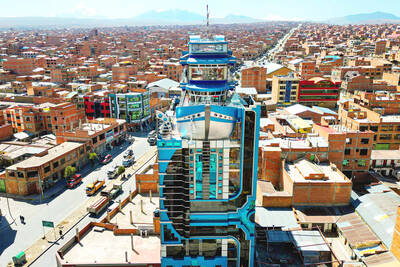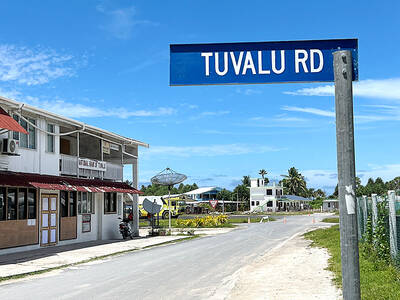The rising Mississippi River broke through a levee, inundating thousands of hectares of farmland, as floodwaters moved south into Illinois and Missouri. At least seven people have died in the worst flooding in a decade in some areas.
But even as the water jeopardized scores of additional homes and businesses, officials said the damage could have been worse if the federal government had not taken steps to clear flood-prone land after historic floods in 1993.
The flooding, which has claimed at least five lives in Iowa and two in Wisconsin over the past week, has resulted in thousands being forced from their homes.
On Tuesday, the flooding halted car travel over two bridges linking Illinois and Iowa and covered the tiny farming community of Gulfport and the surrounding area with 3m of water.
“I’m not going back after this one,” 83-year-old Lois Russell said as she watched water surround her house near Gulfport.
It was the third time she had fled her home because of flooding since 1965.
“It was a good place to raise my seven kids,” she said, crying.
The area was inundated after the Mississippi River, the US’ main internal commercial waterway, broke through a levee near Gulfport. Authorities had to rescue at least a half a dozen people by helicopter, boat and four-wheeler.
US President George W. Bush, whose administration was sharply criticized for its handling of the situation in the wake of the 2005 Hurricane Katrina along the US Gulf Coast, was briefed on the damage and plans to visit the area today.
A 6.4m railway outside Gulfport broke in four sections on Tuesday night, sending flood waters into the evacuated town. Henderson County Sheriff Mark Lumbeck said Gulfport has about 3m of water.
Preliminary estimates were that the flooding has caused more than US$1.5 billion in damage in Iowa, and that figure will undoubtedly rise as the high water moves downstream.
Still, officials said the cost would have been even higher if the federal government had not purchased low-lying land after the 1993 deluge, which caused US$12 billion in damage.
Since then, the government bought out more than 9,000 homeowners, turning much of the land into parks and undeveloped areas that can be allowed to flood with less risk.
The Federal Emergency Management Agency (FEMA) has moved or flood-proofed about 30,000 properties.
The effort required whole communities to be moved, such as Rhineland, Missouri, and Valmeyer, Illinois.
In Iowa, FEMA spent US$1.6 million to buy out residents of Elkport, population 80, and then knock down the village’s remaining buildings. Some residents moved to Garber, Elkport’s twin city across the Turkey River, but others abandoned the area.
On Tuesday, flooding remained far more serious in parts of southeast Iowa, where the Mississippi River had yet to crest.

HISTORIC: After the arrest of Kim Keon-hee on financial and political funding charges, the country has for the first time a former president and former first lady behind bars South Korean prosecutors yesterday raided the headquarters of the former party of jailed former South Korean president Yoon Suk-yeol to gather evidence in an election meddling case against his wife, a day after she was arrested on corruption and other charges. Former first lady Kim Keon-hee was arrested late on Tuesday on a range of charges including stock manipulation and corruption, prosecutors said. Her arrest came hours after the Seoul Central District Court reviewed prosecutors’ request for an arrest warrant against the 52-year-old. The court granted the warrant, citing the risk of tampering with evidence, after prosecutors submitted an 848-page opinion laying out

STAGNATION: Once a bastion of leftist politics, the Aymara stronghold of El Alto is showing signs of shifting right ahead of the presidential election A giant cruise ship dominates the skyline in the city of El Alto in landlocked Bolivia, a symbol of the transformation of an indigenous bastion keenly fought over in tomorrow’s presidential election. The “Titanic,” as the tallest building in the city is known, serves as the latest in a collection of uber-flamboyant neo-Andean “cholets” — a mix of chalet and “chola” or Indigenous woman — built by Bolivia’s Aymara bourgeoisie over the past two decades. Victor Choque Flores, a self-made 46-year-old businessman, forked out millions of US dollars for his “ship in a sea of bricks,” as he calls his futuristic 12-story

FORUM: The Solomon Islands’ move to bar Taiwan, the US and others from the Pacific Islands Forum has sparked criticism that Beijing’s influence was behind the decision Tuvaluan Prime Minister Feletei Teo said his country might pull out of the region’s top political meeting next month, after host nation Solomon Islands moved to block all external partners — including China, the US and Taiwan — from attending. The Pacific Islands Forum (PIF) leaders’ meeting is to be held in Honiara in September. On Thursday last week, Solomon Islands Prime Minister Jeremiah Manele told parliament that no dialogue partners would be invited to the annual gathering. Countries outside the Pacific, known as “dialogue partners,” have attended the forum since 1989, to work with Pacific leaders and contribute to discussions around

END OF AN ERA: The vote brings the curtain down on 20 years of socialist rule, which began in 2005 when Evo Morales, an indigenous coca farmer, was elected president A center-right senator and a right-wing former president are to advance to a run-off for Bolivia’s presidency after the first round of elections on Sunday, marking the end of two decades of leftist rule, preliminary official results showed. Bolivian Senator Rodrigo Paz was the surprise front-runner, with 32.15 percent of the vote cast in an election dominated by a deep economic crisis, results published by the electoral commission showed. He was followed by former Bolivian president Jorge “Tuto” Quiroga in second with 26.87 percent, according to results based on 92 percent of votes cast. Millionaire businessman Samuel Doria Medina, who had been tipped